
1. Studying From Visual Mappings
1.1. Imprint the skeleton: create a mental image of the skeleton of your mapping. Memorize it.
1.2. Visualize: without looking at the visual mapping, pull the image from memory.
1.3. Recite: recite the skeleton and then recite details about each heading. Look at the details on the visual mapping to check your accuracy.
1.4. Reflect: use a reflect activity for elaborative rehearsal.
1.5. Review: use ongoing review to mentally rehearse and recite the visual mapping multiple times.
2. Levels of information in Hierarchies
2.1. Hierarchies: are diagrams that place the topic on the top line of a diagram with main ideas branching down from the topic, followed by details branching down from the main ideas.
2.1.1. Level one and level two information: The Hierarchy Skeleton.
2.1.1.1. Level one and level two information in hierarchies is identical to level one and level two information used in visual mappings. The skeleton of a hierarchy that you will visually memorize includes the topic and the level two headings or main ideas.
2.1.2. Level three and level four information: Supporting Details
2.1.2.1. Be very selective. Use only key words or short phrases for level three and level four details.
3. Studying from Hierarchies
3.1. Comparison Charts: are diagrams that organize information for two or more subjects into a chart or a grid with columns and rows.
3.1.1. Be selective, use dashes or bullets, leave cells blank.
3.2. Attaching other forms of notes: sometimes a printed section of material will contain important information that does not fit within the categories of your chart. When this happens such information, you may write a paragraph, create a list of the important points, or redraw a diagram next to or following your comparison chart.
4. Visual Notes
4.1. Form of note taking that organizes information into diagrams or charts that use color, pictures, and shapes to help imprint info into visual memory
4.2. Utilize memory strategies, involve multi sensory skills and personalize info
4.2.1. Use colors, pictures, symbols and graphic formats to create strong visuals
4.2.1.1. Organize and rearrange information in meaningful ways to use as study tools
4.2.1.1.1. Promote effective recitation, lead to collaborative rehearsal, and increase concentration
5. Visual Mapping
5.1. Diagrams that place the topic in the center of a diagram with main ideas branching off the center, followed by details branching off main ideas
5.1.1. Level one information: refers to the subject or topic of the visual notes
5.1.2. Level two information: refers to the main ideas associated with or linked to the specific topic
5.1.3. Level three information: refers to the major supporting details that explain, support, or prove the main idea.
5.1.4. Level four information: refers to the minor details that directly explain or support level-three information.

